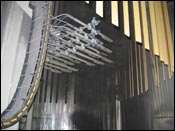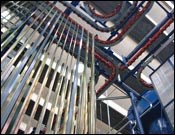Quality, Italian-Style
A Vertical powder coating operation where Excellence pervades the Company Culture
Italians seem to have a knack for quality. They pride themselves on having the best of the best—expensive cars, fine wine, soft leather handbags, masterpiece art and even “la dolce vita,”—the highest quality of life.
Adding a top-of-the-line architectural aluminum finish to the list is Hydro Aluminum Colors, a vertical powder coating operation based in Ornago, Italy.
Featured Content
Over the past few years, coaters around the world have gradually raised the bar for quality standards. The degree to which a coater is truly committed varies greatly depending on the product and the environment where it will be used. For example, the cover for an automotive oil filter doesn’t require the same finish quality as the vehicle’s exterior body panels.
Architectural aluminum is one product that has particularly high standards for finish quality. The finished pieces are used in very large structures that cannot be easily repaired or repainted, and buildings can be subjected to extreme weather conditions including sun, rain, snow and severe temperature changes. In short, aluminum must stay good-looking for a long time in a harsh world. That kind of end-use demands the highest possible quality, and all coaters of architectural aluminum have very high standards and methods of measuring and controlling the quality of the finish.
With a particularly exceptional operation that constantly measures and controls for appearance and performance, Hydro processes 70,000 tons of aluminum a year—more than 50 tons/day.
Hydro, an international company headquartered in Norway, has divisions throughout Europe. The company provides aluminum to many different industries with different finishes, including anodizing and powder coating.
The Ornago plant operates a large powder operation able to handle aluminum extrusions up to 7 m (approximately 24 ft) long that are hung vertically on very close centers on a line that travels at 1.5 m/min (5 fpm). The hanging pattern creates a large wall of product traveling through the line, and it coats about 8 m2/min (approximately 86 ft2/min).
High volume coupled with high standards places challenging demands on quality control at the plant. Not only must the coating be top-notch, but the cost of a defect is enormous.
This pressure—very high quality with very few defects—defines the operation at Ornago. Quality is not just a stated policy; it is a steady and unwavering reality.
General Operation
Hydro applies more than 600 colors to 2,500 different window shapes. The company keeps 1,500 different window shapes—more than 2,000 tons of aluminum—in stock at all times. Finishing line personnel make 25–30 color changes/day on two shifts and recover every color on every run. Each color change takes between 4 and 30 min, depending on how long they were in the previous color and how dissimilar it is from the new color being set up for the next run. The finishing system uses two operators in the powder application area and four operators in the load/unload area; the plant’s quality department has a single supervisor and two assistants.
The Finishing Process
Finishing begins with pretreatment, starting with an alkaline cleaner/degreaser. Parts then travel through a de-oxidation stage to remove the natural oxide layer from the aluminum surface. This is followed by another cleaner stage before a chromium-based conversion coating is applied, and the final pretreatment stage consists of a deionized water rinse. The chrome conversion coating provides exceptional corrosion resistance that, when combined with a minimum of 60 μm of TGIC powder, allows the company to provide a 10-year warranty in a seacoast environment.
Because the aluminum pieces will be exposed outdoors, it’s critical to use a high-performance conversion coating to prevent corrosion under the coating. Extruders have traditionally used chrome to provide the required adhesion and corrosion resistance. But recent technology advances have improved performance of non-chrome conversion coatings, and testing is well underway at Hydro on a non-chrome substitute that will definitely be implemented in the near future.
The company’s cleaner and some of the rinse stages of the washer use vertical risers with nozzles, while the chemical treatment stage and rinse after treatment use a cascade flow from the top of the washer. The cascade system uses low-maintenance trays to direct the flow of conversion coating solution down over the top of the extrusions, like a waterfall. This eliminates the use of hundreds of spray nozzles typically found inside the washer tunnel of a vertical coating line, reducing the motor horsepower requirement of the pump and cutting the cost of chemicals and water related to spray losses. It also eliminates maintenance associated with cleaning, aligning and, when needed, replacing nozzles.
The pretreatment process feeds two powder coating lines. The conveyor features a unique hanger arrangement that allows the extrusions to be moved from one line to another so they can be routed to a clean booth for a fresh color. The intersection of the two lines uses a pusher system to move a pin from one holder into another on a different line.
Each line has one vertical powder coating booth complete with automatic powder application equipment and high-efficiency cyclone powder recovery system. One booth can be in use while the other is being cleaned. Powder coating of both sides of the extrusion is accomplished by rotating the extrusions 180° at the mid-point of the vertical booth.
Spray booths are designed with a thin plastic wall that can be indexed from a feed roller to a take-up roller when a clean wall is needed. Replacing the dirty wall with a clean sheet of plastic saves a tremendous amount of time, because operators do not have to blow powder off the booth walls—the secret to Hydro’s ability to accomplish very fast color changes while reclaiming every color.
The booths’ reclaim extraction duct is located along the vertical area between two rolls of plastic and also along the floor at the bottom of the booth. A feed center provides clean and fast color change, and powder guns are cleaned by automatic purge from an air manifold.
One of the two booths has 16 powder guns; the second has 20 guns mounted on three horizontal gun bars that are moved up and down by a long-stroke reciprocator. Stroke speed is set to provide uniform coverage based on the design line speed. The application area isn’t enclosed in a powder room, but the powder materials are all stored in an environmentally controlled room and then moved to the line when needed.
The dual line also enables application of a double coat of powder for wood-grain looks and other special applications. A wood-grain effect uses an automated powder-on-powder application to provide a realistic wood appearance in different grains and colors.
Coated pieces cure in a gas-fired convection oven. Because electricity is expensive, use of electric infrared isn’t cost-effective. Coating line managers maintain a line gap of 5 m (16 ft) to allow time for a color to begin to gel before the next color enters the oven. This short gap provides enough exposure time to avoid excess velocity and cross-contamination of powder colors. The long extrusions are clipped together at the bottom to prevent them from swinging into one another in the cure oven.
Quality Standards
Hydro is Qualicoat Class 2 certified for aluminum extrusion. The Qualicoat standard was established in Europe to provide specifications for processing aluminum used in building construction. Qualicoat standards require minimum specific goals for process, testing and performance. A licensed process that allows those who qualify to use a label indicating they meet the requirements, Qualicoat covers test methods and requirements, work specifications, approval of coatings to be used, licensing process of coating plants and specifications for in-house control.
The Class 2 standard was created to meet demands for increased weathering resistance for rigorous architectural projects and to ensure consistent, high-quality coating. It requires gloss retention of at least 90% after one year, 75% after two years and 50% after three years of exposure in Florida. Companies that meet this standard pay for annual audits to confirm continued compliance and maintain their licenses.
The standards also specify minimum requirements for laboratory test equipment, which include: a specular glossmeter, two coating thickness gages, an analytical balance, cutting tools, an indentation hardness tester, adhesion test equipment, an impact tester, a temperature-recording device, a conductivity meter, a bend tester, a test solution for the Machu test, and test solutions for a polymerization test. In addition to these test devices, the lab at Ornago includes a humidity test cabinet and salt-spray test chamber.
The Qualicoat 2 test standards are relatively comparable to an American Architectural Manufacturers Association specification called AAMA 2604-98. This is one of three standards with different quality levels created for the American architectural market. Voluntary specifications with test procedures and performance requirements for high-performance organic coatings on aluminum extrusions, the AAMA standards cover tests to be conducted, how to prepare test specimens, metal preparation methods and reporting.
Portable gages are used for color and film thickness testing every 50 m of production, including a measurement of film build of the powder prior to cure. The minimum required film build is 60 μm, and anything over 89 μm is unacceptable—that’s a film build tolerance less than 1 mil from minimum to maximum.
Coating thickness must be measured in at least five areas of each part sampled, with 3–5 readings in each area. None of the measurements can be below 80% of the minimum requirement.
Hydro’s standards also require a minimum of 1,000 hr of salt-spray testing with coating weights of 0.06–1.2 g/m2 of chrome. Technicians perform a Machu corrosion test, where the part is scribed and immersed in an acidic solution for 48 hr at 37ºC. The standard requires no infiltration of the coating exceeding 0.5 mm on both sides of the scribe line.
Quality personnel also conduct regular thermal testing, plus measurement of color, gloss and adhesion. Weathering is a critical part of testing requirements in the Qualicoat standards, so Hydro continuously runs accelerated and long-term testing. Gloss must be greater than 10% of the original after 1,000 hr of cyclic testing, and ΔE (delta E, or color difference) must not be greater than 50% of the values included in a table created for color shift.
The powder coating line is designed to operate with a large number of colors and short lead times. Hydro runs flexible schedules that can include 5–7 days a week and 1–3 shifts so it can meet immediate demands for specific projects.
The finished product, with its high-quality coating, is shipped directly to the job site or to one of 22 distribution centers worldwide
RELATED CONTENT
-
Understanding Corrosion and Salt Spray
How it’s produced, NSS testing and how to get the best results possible.
-
Aluminum Anodizing
Types of anodizing, processes, equipment selection and tank construction.
-
Smut and Desmutting
Question: I am new to this industry and have heard about smut and desmutting operations.





















